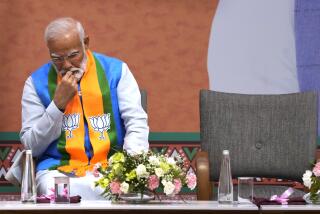The Consequences of Rushing to Modernity
- Share via
CHEVERELY, MD. — Over the weekend, India’s 13-day-old Hindu nationalist government was replaced by a coalition of 13 leftist and regional parties after Prime Minister Atal Bihari Vajpayee failed to assemble a majority in Parliament. The new government has 11 days to produce a working majority.
The Indian Parliament today is a large quilt of numerous ideological, ethnic and regional patches. None of the parties represented in it has a countrywide following. Vajpayee’s Bharatiya Janata Party (BJP), the largest, could not muster more than 194 votes in the 535-member body. The new government of Prime Minister H.D. Deve Gowda is expected to gain a parliamentary majority with the help of the Congress Party, the second largest grouping in Parliament.
Scrambled as it is, the Parliament mirrors the endless diversity of the Indian population. Earlier this century, much of the country was united by Mahatma Gandhi and Jawaharlal Nehru, under the banner of the Indian National Congress, in their fight against British colonialism. A semblance of that unity was nurtured by the Nehru dynasty through the Congress Party and its creed of secularism and socialism.
But the “Nehruvian consensus” has come unglued. Socialism is blamed for the country’s economic stagnation, and the government has begun to liberalize the economy. The dynasty is gone, and its political vehicle, the Congress Party, reeks of corruption. The BJP, which has stepped up to fill the void, offers Hindu nationalism as a substitute for secularism. It considers the Muslim culture the main challenge to its program. Muslims make up 12% of the Indian population of 930 million.
The BJP would introduce a Hinduized civil code that would bar Muslims from following their separate practices in marriage, inheritance and alimony. It would compel Muslim children to be instructed in Hinduized curricula at public schools. “There is only one Indian culture,” Vajpayee recently told the German newspaper Der Spiegel, “whose root is Hinduism, and the Muslims are only a part.”
Polls show that the BJP’s popularity has increased since the elections, from 23% in mid-April to 50% in mid-May, when it formed the Cabinet. After his setback last week, Vajpayee said that he will “continue our struggle till we attain a majority in the house.” The question is whether his “Hindu nation” is viable or good for India.
Islam has indeed proved to be a weak glue for Muslim nationhood on the subcontinent. The creation of Pakistan was predicated on the idea that Muslims were a single nation, different from Hindus. Two decades later, Pakistan’s eastern province broke away to become the subcontinent’s second Muslim nation-state, Bangladesh. Now Muslims in India’s Kashmir valley are fighting for a third Muslim nation-state, while a fourth Muslim nationalist movement simmers in Pakistan’s Sindh province.
But while Hindu nationalists scorn Muslim nationalism, they appear not to have looked at themselves in the mirror. The subcontinent’s Hindu society is far more ethnically diverse than its Muslim counterpart, and four times as large. Indian Hindus speak 15 major languages, 1,600 dialects. They are divided into thousands of castes and tribes. And India has been stalked by a half-dozen nationalist movements since its independence.
The concept of nationalism was imported by our British-educated leaders. Hindu leaders Gandhi and Nehru, along with their Muslim counterpart, Mohammed Ali Jinnah, studied law and politics in Britain and were fascinated by the debates in the House of Commons. When they returned to India, they set about remolding their country to conform to the European model of a nation-state. But Europe’s nations evolved over centuries. Trade, commerce and industry lured people from the countryside into urban polyglots. There, cross-cultural communication and interaction gradually weakened the hold of old religious and ethnic loyalties. National civic cultures were born. Catholics and Protestants became Frenchmen, Spaniards and Britons.
The 700 million Indian Hindus are no more a single nation than the 350 million European Christians. Still, much of India can evolve a common civic culture through economic modernization. But any attempt to produce a “national culture” by force-feeding Muslims and others the BJP brand of Hindu cultural froth would spell disaster. Muslim nationalism on the subcontinent was fueled by the same kind of anti-Muslim campaign that Hindu nationalists are carrying on today. And, unfortunately, the secular Hindu leadership fell into the nationalists’ trap.
On the eve of India’s independence, a British Cabinet mission proposed a confederation of what is now India, Pakistan and Bangladesh. It remains the best solution to the subcontinent’s nationalist ferment and should be debated afresh. Jinnah accepted the Cabinet Mission Plan. So did Gandhi and other leaders of the secular Congress Party. But Nehru later spurned the idea because it would have given the Muslim-majority regions greater autonomy than he preferred. As a result, Muslims, ever fearful of cultural submergence, could not be swayed from their Pakistan demand.
Throughout history, the subcontinent has swung between periods of harmony, embodied in empires, and disarray. Modern economies are producing a truer regional harmony through trading blocs--the European Union, North Atlantic Free Trade Union, Asia Pacific Economic Cooperation, and so on. The economies of the subcontinent have begun to modernize. Our traders and industrialists of tomorrow will usher in the next age of subcontinental harmony. Meanwhile, Vajpayee would better serve India by helping to modernize its economy rather than trying to Hinduize its Muslim citizens.*
More to Read
Sign up for Essential California
The most important California stories and recommendations in your inbox every morning.
You may occasionally receive promotional content from the Los Angeles Times.













